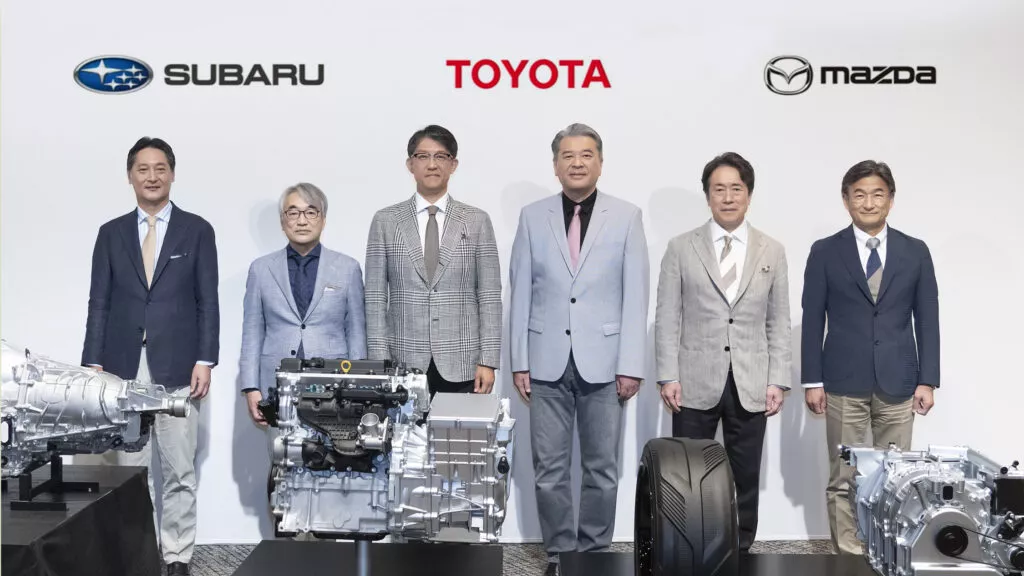Each company will concentrate on its respective engine type, with Toyota focusing on inline-fours, Subaru on boxers, and Mazda on rotary engines
- Subaru, Toyota, and Mazda, agree that carbon is the enemy, collaborating on a “multi-pathway” approach for the future of ICE.
- Each company will keep developing its own “signature” powertrain, including boxer (Subaru), in-line four (Toyota), and rotary (Mazda) units.
- The new combustion engines will be tailored to electrification, while being compatible with different types of carbon-neutral fuels.
Japanese automakers Toyota, Subaru, and Mazda convened today to announce their collaborative efforts in preserving internal combustion engines by developing a new generation of clean and efficient powertrains. Rather than pursuing a shared series of engines, each company will focus on its unique type of powertrain while sharing technologies. It’s worth noting that Toyota owns about a fifth of Subaru and roughly 5% of Mazda.
about:blank
This new generation of powertrains will be purposefully designed for electrification, featuring a more compact size and compatibility with a variety of carbon-neutral fuels, aligning with the path towards decarbonization.
The joined “multi-pathway approach” from Japan takes place amidst a global EV slowdown, showing that ICE still has a future in the automotive world.
about:blank
Each company will develop its own type of engine
Subaru, Toyota, and Mazda made it clear that they will remain competitors in the “product arena”, offering “unique engines and cars”. However, they all agreed that carbon is the enemy, and will collaborate on expanding the available options. In this context, each company will develop its “signature” powertrain – a boxer engine for Subaru, inline-fours for Toyota, and rotary engines for Mazda – catering the needs of their diverse customer bases.
Targeting the decarbonization of ICE, the companies will optimize the integration of electric drive units on their respective powertrains, resulting in a new generation of hybrids. Carbon neutrality will also be achieved by shifting away from fossil fuels and focusing on alternatives solutions like e-fuel, biofuels, and liquid hydrogen, which are already being tested in racing.
The new combustion engines are described as “highly efficient and powerful”, promising to offer improved performance. They will also be smaller in size, allowing future models to have lower hoods and better aerodynamics. Finally, engineers will make sure that the mills comply with the increasingly strict emission regulations in different markets around the world.
about:blank
The official photos show a camouflaged prototype of the Crosstrek featuring Subaru’s next-gen hybrid system. Toyota showed a Prius prototype with a new 1.5-liter four-cylinder engine currently under development, in addition to a larger displacement 2.0-liter unit. On the other hand, Mazda exhibited its rotary-EV system featuring one or two rotors, which act as power generators.
Statements from the CEOs
Atsushi Osaki, President and CEO of Subaru, said: “Achieving a carbon-neutral society is a challenge that must be undertaken by all of Japan’s industries and society as a whole. As we continue to refine electrification technology, we will also enhance our horizontally-opposed engines with an aim to use carbon-neutral fuels in the future. Moving forward, the three companies sharing the same aspiration will continue to advance the pursuit of sustainable excellence in Japanese car manufacturing.”
Koji Sato, President and CEO of Toyota added: “In order to provide our customers with diverse options to achieve carbon neutrality, it is necessary to take on the challenge of evolving engines that are in tune with the energy environment of the future. The three companies, which share the same aspirations, will refine engine technologies through friendly competition.”
Finally, Masahiro Moro, President and CEO of Mazda stated: “We will continue to offer customers exciting cars by honing internal combustion engines for the electrification era and expanding the multi-pathway possibilities for achieving carbon neutrality. Given the rotary engine’s compatibility with electrification and carbon-neutral fuels, Mazda will continue to develop the technology through co-creation and competition to ensure it can contribute broadly to society.”

